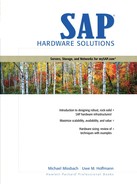Summary
To implement the IT infrastructure, it is useful to know something about the business applications being implemented. The business applications determine the important data processing requirements, from a performance, availability, and total cost of ownership view. SAP introduced many new business applications as part of the mySAP.com initiative. The first part of this chapter provided a brief introduction of the major mySAP.com business application components. The terms defined are referenced in the remaining chapters in this book. Here are some of the important points in this chapter:
There are many business application components in the mySAP.com solution offering. However, a mySAP.com Workplace system and an SAP R/3 system are the minimum required.
Application Link Enabling (ALE) provides the ability to synchronize the databases of distributed SAP systems. ALE is the technological basis for the coupling of mySAP.com business applications.
SAP supports multiple national languages. However, some language combinations cause additional administrative effort.
The SAP architecture is based on distinct tiers for user interface (presentation), business logic execution (application), and business data storage (database). An additional tier (middle ware) is mandatory for browser access to mySAP.com business applications.
Because the application logic in any one system can be executed in parallel, the workload can be distributed between multiple application servers. Each system only has one database server, so it is critical for all operations.
Depending on system workload, application and database tiers can be consolidated onto a central system, executed on a single server.
Multiple SAP application components can be executed in parallel on one server. Multiple SAP application and database instances can be executed on a single server box, if needed for consolidation purposes.
The message and the enqueue work processes are unique in each SAP system. The instance running the enqueue and message work processes is the Central Instance (CI). There's only one CI possible per SAP system.
A typical SAP System Landscape includes at least a development system, a test system, and the production system. This applies to most of the mySAP.com components.
Many of the mySAP.com components are based on an SAP basis kernel and a single database instance. Middleware components like Internet Transaction Server and Business Connector deploy a different kernel and have no database.
